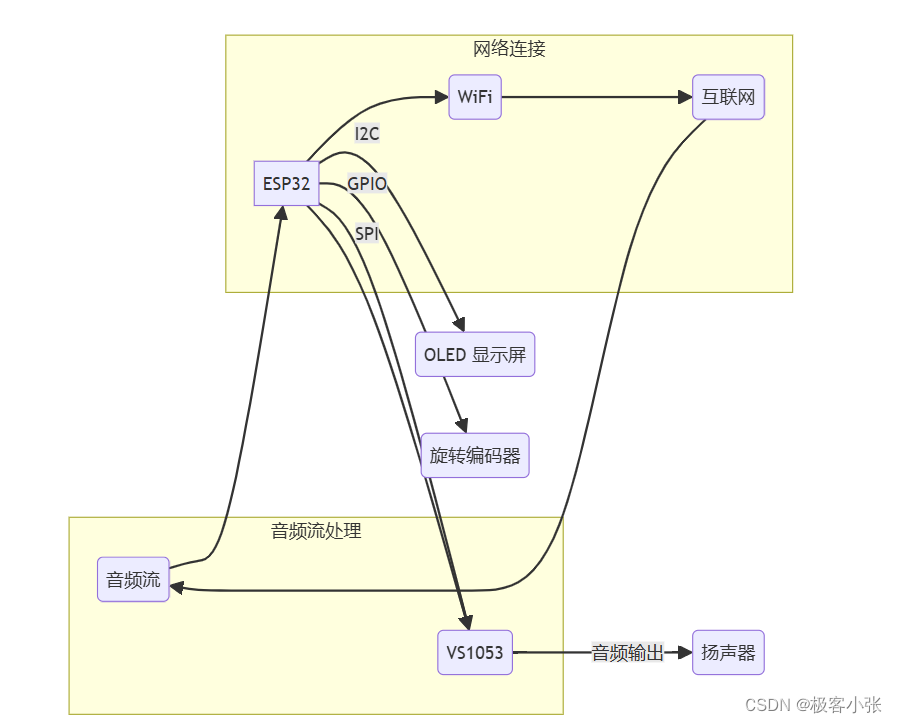摘要: 本文将详细介绍如何使用 ESP32 开发板制作一个功能完备的网络收音机。我们将涵盖硬件选择、软件架构、网络连接、音频流解码、用户界面设计等方面,并提供完整的代码示例和详细的解释,帮助您轻松构建自己的网络收音机。
关键词: ESP32, 网络收音机, VS1053, Arduino, 音频流, HTTP, MP3, AAC
1. 项目概述
1.1 功能简介
本项目旨在利用 ESP32 的强大性能和丰富的功能,打造一款可以播放互联网广播的网络收音机。主要功能包括:
- 通过 WiFi 连接互联网
- 搜索并播放网络电台
- 支持多种音频流格式,例如 MP3, AAC 等
- 通过编码器调节音量和切换电台
- 使用 OLED 显示屏显示电台信息
1.2 硬件组成
以下是本项目所需的硬件清单:
- ESP32 开发板 (例如: ESP32-DevKitC)
- VS1053 MP3 解码模块
- OLED 显示屏 (例如: SSD1306 128x64)
- 旋转编码器
- 扬声器 (8Ω, 3W)
- 面包板和跳线
1.3 软件架构
本项目采用 Arduino IDE 进行开发,主要使用的库包括:
- WiFi.h: 用于连接 WiFi 网络
- HTTPClient.h: 用于发送 HTTP 请求获取音频流
- VS1053.h: 用于控制 VS1053 解码模块
- Wire.h: 用于与 I2C 设备 (OLED 显示屏) 通信
- Adafruit_SSD1306.h: 用于控制 SSD1306 OLED 显示屏
- Encoder.h: 用于读取旋转编码器的值
以下是软件架构图:
2. 硬件连接
请参考以下电路图连接硬件:
3. 软件实现
3.1 代码示例
#include <WiFi.h>
#include <HTTPClient.h>
#include <VS1053.h>
#include <Wire.h>
#include <Adafruit_SSD1306.h>
#include <Encoder.h>
// WiFi 设置
const char* ssid = "你的WiFi名称";
const char* password = "你的WiFi密码";
// 电台列表
const char* radioStations[] = {
"http://icecast.spc.org.au/3pbsfm",
"http://stream.radioparadise.com/flac-320",
// 添加更多电台...
};
const int numStations = sizeof(radioStations) / sizeof(radioStations[0]);
// 当前电台索引
int currentStation = 0;
// VS1053 引脚定义
#define VS1053_CS 5
#define VS1053_DCS 16
#define VS1053_DREQ 4
// OLED 显示屏引脚定义
#define OLED_SDA 21
#define OLED_SCL 22
// 旋转编码器引脚定义
#define ENCODER_CLK 18
#define ENCODER_DT 19
#define ENCODER_SW 23
// 实例化对象
VS1053 player(VS1053_CS, VS1053_DCS, VS1053_DREQ);
Adafruit_SSD1306 display(128, 64, &Wire);
Encoder encoder(ENCODER_CLK, ENCODER_DT);
void setup() {
Serial.begin(115200);
// 初始化 VS1053
player.begin();
player.setVolume(5); // 设置初始音量
// 初始化 OLED 显示屏
display.begin(SSD1306_SWITCHCAPVCC, 0x3C);
display.clearDisplay();
display.setTextSize(2);
display.setTextColor(WHITE);
display.setCursor(0, 0);
display.print("Connecting...");
display.display();
// 连接 WiFi
WiFi.begin(ssid, password);
while (WiFi.status() != WL_CONNECTED) {
delay(500);
Serial.print(".");
}
Serial.println("WiFi connected!");
Serial.print("IP address: ");
Serial.println(WiFi.localIP());
// 显示第一个电台信息
displayStationInfo();
}
void loop() {
// 读取编码器数值
int encoderValue = encoder.read();
if (encoderValue != 0) {
// 调整音量或切换电台
if (encoderValue > 0) {
currentStation = (currentStation + 1) % numStations;
} else {
currentStation = (currentStation - 1 + numStations) % numStations;
}
playStation(radioStations[currentStation]);
}
// 播放音频流
if (player.available()) {
// 从网络读取音频数据
HTTPClient http;
http.begin(radioStations[currentStation]);
int httpCode = http.GET();
if (httpCode > 0) {
if (httpCode == HTTP_CODE_OK) {
WiFiClient client = http.getStream();
while (client.connected()) {
// 将音频数据发送到 VS1053
if (player.readyForData()) {
uint8_t buffer[32];
size_t bytesRead = client.read(buffer, sizeof(buffer));
player.playData(buffer, bytesRead);
}
}
}
} else {
Serial.printf("HTTP request failed, error: %s\n", http.errorToString(httpCode).c_str());
}
http.end();
}
}
void playStation(const char* url) {
// 停止播放
player.stopSong();
// 显示电台信息
displayStationInfo();
// 开始播放新电台
// (注意: 实际播放逻辑在 loop() 函数中处理)
}
void displayStationInfo() {
// 在 OLED 显示屏上显示电台信息
display.clearDisplay();
display.setCursor(0, 0);
display.print("Radio:");
display.setCursor(0, 16);
display.print(radioStations[currentStation]);
display.display();
}3.2 代码解释
- 包含头文件: 引入必要的库文件,包括 WiFi, HTTPClient, VS1053, Wire, Adafruit_SSD1306 和 Encoder。
- 定义变量: 定义 WiFi 连接信息、电台列表、当前电台索引、引脚定义和实例化对象。
- setup() 函数: 初始化串口、VS1053、OLED 显示屏,连接 WiFi 并显示初始信息。
- loop() 函数: 循环读取编码器数值,根据数值调整音量或切换电台,并持续从网络获取音频数据发送到 VS1053 播放。
- playStation() 函数: 停止当前播放,更新电台信息并准备播放新电台。
- displayStationInfo() 函数: 在 OLED 显示屏上显示当前电台信息。
4. 项目扩展
本项目可以进行以下扩展:
- 添加更多功能: 例如,可以添加时钟显示、闹钟功能、睡眠定时器等。
- 改进用户界面: 例如,可以使用更美观的界面库,或者使用 TFT 彩屏显示更丰富的电台信息。
- 支持更多音频格式: 例如,可以添加对 FLAC、OPUS 等音频格式的支持。
- 实现远程控制: 例如,可以使用手机 App 通过蓝牙或 WiFi 控制网络收音机。
5. 总结
本文介绍了如何使用 ESP32 制作一个功能完备的网络收音机,并提供了详细的代码示例和解释。您可以根据自己的需求对项目进行修改和扩展,打造属于自己的个性化网络收音机。
知识点参考链接
- ESP32:
- OLED 显示屏:
- Arduino IDE:
- HTTP 通信:

